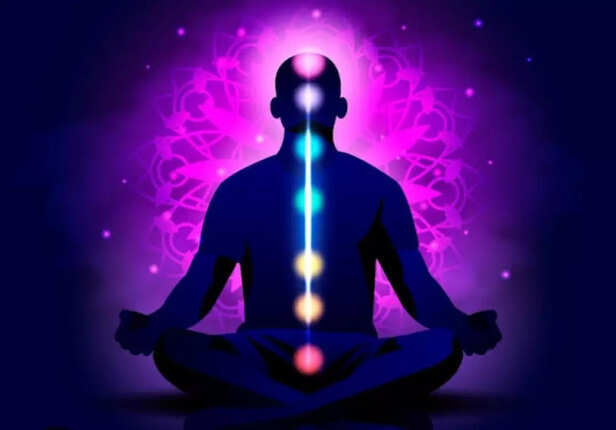A Bhagavad Gita-Inspired 5-Step Process to Calm Your Mind—Krishna’s Therapy Session
Ankit Gupta | May 08, 2025, 23:48 IST
Lord Krishna
( Image credit : Freepik )
“You are not your anxiety. You are the observer, the warrior, and the soul beyond it.” Anxiety is not your enemy. It is your invitation. The Gita does not promise a life free of storms, but teaches you to become the calm within the storm. You are not your anxiety. You are the observer, the warrior, and the soul beyond it all.
In the chaos of modern life, with deadlines pressing in, relationships fraying, and an overwhelming digital world at our fingertips, anxiety has become an unwelcome companion for many. Therapy, mindfulness, and self-help books all offer support—but what if we turned to one of the oldest wisdom texts in human history for answers?
The Bhagavad Gita, the sacred dialogue between Lord Krishna and Arjuna on the battlefield of Kurukshetra, is not just a spiritual scripture—it is a manual for inner stability. In its verses, we find profound psychological guidance, strategies for emotional resilience, and, above all, a roadmap to navigate the storms of the mind.
Let us now enter “Krishna’s Therapy Session”—a 5-step process inspired by the Gita that helps you calm anxiety, find clarity, and reconnect with your deeper self.

– Bhagavad Gita 2.15
In the opening of the Gita, Arjuna is overwhelmed. His body trembles. His mind is clouded. He feels lost.
Krishna’s first response is not to dismiss the emotion—but to bring awareness to it.
Anxiety thrives in confusion. But the moment we turn the light of awareness on it, it begins to loosen its grip.
When anxiety hits, take a moment. Pause.
Ask yourself:
This externalization creates emotional distance. By naming your anxiety, you stop being it. You become the seer, not the storm.
Just as Krishna urges Arjuna to observe his dilemma with wisdom, we too must develop the courage to observe our inner weather patterns without fear.

– Bhagavad Gita 2.47
Much of our anxiety is born not from action, but from obsession with its result.
Will it work? Will they like me? What if I fail?
In these moments, Krishna’s timeless teaching becomes a balm to the soul:
Do your best, but let go of the rest.
Instead of spinning in the cycle of “what ifs,” try surrendering:
Write down your anxious thought, and then follow it with this affirmation:
“I release control over _____. I trust that life is unfolding as it should.”
This is not passivity. It’s power.
Letting go does not mean giving up. It means acknowledging that you are not the whole universe—but you are a meaningful part of it.
Krishna’s wisdom reminds us: Detachment is freedom, not coldness. It is the art of doing without drowning.

– Bhagavad Gita 2.48
When anxiety takes over, it drags us either into the regrets of the past or the fears of the future.
But Krishna again and again brings Arjuna back to the present—to this arrow, this breath, this battle.
The 5-4-3-2-1 Grounding Technique
Use your senses to bring yourself out of your mind and back into the moment:
You are no longer spinning—you are standing.
And isn’t this what Krishna calls “Yoga”? Not twisted postures, but the union of attention and intention.
Anxiety says: “Run.”
Yoga says: “Root.”

– Bhagavad Gita 17.3
Anxiety paralyzes. It convinces you that you must wait until you “feel better” to act.
But the Gita flips this: it says, act anyway—and your feelings will follow.
Krishna urges Arjuna to fight—not because he’s fearless, but because it's the right thing to do despite his fear.
Ask yourself:
“If I were acting from courage instead of fear, what would I do?”
Then do one small version of that.
Not a huge leap. Just one step.
This is Karma Yoga—not blind doing, but doing with awareness.
And when you take action from your soul rather than your fear, you rewire your identity.
You move from “I feel anxious” to “I am becoming brave.”

– Bhagavad Gita 2.20
The deepest layer of anxiety is existential.
What if it all falls apart? What if I fail? What if I lose everything?
At this point, Krishna doesn’t just coach—he comforts. He reminds Arjuna (and all of us):
You are not this body. You are not this story. You are the eternal soul.
This truth is not meant to negate our problems, but to give us a larger lens.
Write a letter from your wiser self, your future self, or the divine Krishna to the anxious version of you today.
It could say things like:
“This moment will pass. I know it feels overwhelming, but you are growing through it.”
“You are stronger than you think, and loved more than you know.”
“Your life has a purpose beyond this fear.”
Read it aloud. Hear it. Feel it.
This is Bhakti Yoga—not escapism, but sacred trust.
The Bhagavad Gita was spoken not in a forest or a monastery, but on a battlefield.
It was meant for those who feel torn, those who doubt, and those who suffer inside, even while the world expects them to stay strong.
Krishna doesn’t tell Arjuna to run away. He tells him to rise, to understand himself, and then to act from that place of clarity and courage.
And that is the heart of this therapy session.
You are the one watching it.
You are the witness, the warrior, and the wisdom behind the waves.
Through awareness, detachment, mindfulness, action, and faith,
you learn not how to escape the storm—but how to become still within it.
Because Krishna never promised that life would be easy.
He promised that you are eternal.
And in that truth, there is freedom.
The Bhagavad Gita, the sacred dialogue between Lord Krishna and Arjuna on the battlefield of Kurukshetra, is not just a spiritual scripture—it is a manual for inner stability. In its verses, we find profound psychological guidance, strategies for emotional resilience, and, above all, a roadmap to navigate the storms of the mind.
Let us now enter “Krishna’s Therapy Session”—a 5-step process inspired by the Gita that helps you calm anxiety, find clarity, and reconnect with your deeper self.
Step 1: Awareness – Jnana (Self-Reflection)

Mindfulness
( Image credit : Freepik )
“A person who is not disturbed by happiness and distress and is steady in both is certainly eligible for liberation.”
In the opening of the Gita, Arjuna is overwhelmed. His body trembles. His mind is clouded. He feels lost.
Krishna’s first response is not to dismiss the emotion—but to bring awareness to it.
Anxiety thrives in confusion. But the moment we turn the light of awareness on it, it begins to loosen its grip.
Name the Storm
Ask yourself:
- What exactly am I feeling?
- Where in my body do I feel it?
- What thoughts are fueling this sensation?
This externalization creates emotional distance. By naming your anxiety, you stop being it. You become the seer, not the storm.
Just as Krishna urges Arjuna to observe his dilemma with wisdom, we too must develop the courage to observe our inner weather patterns without fear.
Step 2: Letting Go of Control – Vairagya (Detachment from Outcome)

Detachment
( Image credit : Freepik )
“You have the right to perform your duty, but never to the fruits of action.”
Much of our anxiety is born not from action, but from obsession with its result.
Will it work? Will they like me? What if I fail?
In these moments, Krishna’s timeless teaching becomes a balm to the soul:
Do your best, but let go of the rest.
The Surrender Journal
Write down your anxious thought, and then follow it with this affirmation:
“I release control over _____. I trust that life is unfolding as it should.”
This is not passivity. It’s power.
Letting go does not mean giving up. It means acknowledging that you are not the whole universe—but you are a meaningful part of it.
Krishna’s wisdom reminds us: Detachment is freedom, not coldness. It is the art of doing without drowning.
Step 3: Anchoring in the Present – Dhyana (Mindfulness and Breathwork)

Meditation
( Image credit : Freepik )
“Be steadfast in yoga, O Arjuna. Perform your duty and abandon all attachment to success or failure.”
When anxiety takes over, it drags us either into the regrets of the past or the fears of the future.
But Krishna again and again brings Arjuna back to the present—to this arrow, this breath, this battle.
The 5-4-3-2-1 Grounding Technique
Use your senses to bring yourself out of your mind and back into the moment:
- 5 things you can see
- 4 things you can touch
- 3 things you can hear
- 2 things you can smell
- 1 thing you can taste
You are no longer spinning—you are standing.
And isn’t this what Krishna calls “Yoga”? Not twisted postures, but the union of attention and intention.
Anxiety says: “Run.”
Yoga says: “Root.”
Step 4: Taking Inspired Action – Karma (Purposeful Movement Forward)

Karma Rebacks
( Image credit : Pexels )
“A man is made by his belief. As he believes, so he is.”
Anxiety paralyzes. It convinces you that you must wait until you “feel better” to act.
But the Gita flips this: it says, act anyway—and your feelings will follow.
Krishna urges Arjuna to fight—not because he’s fearless, but because it's the right thing to do despite his fear.
The Opposite Action Challenge
“If I were acting from courage instead of fear, what would I do?”
Then do one small version of that.
Not a huge leap. Just one step.
- Send that email.
- Step outside.
- Sit up straight.
- Speak that truth.
This is Karma Yoga—not blind doing, but doing with awareness.
And when you take action from your soul rather than your fear, you rewire your identity.
You move from “I feel anxious” to “I am becoming brave.”
Step 5: Trusting the Higher Order – Bhakti (Faith and Devotion)

Devotion
( Image credit : Freepik )
“The soul is neither born, nor does it ever die.”
The deepest layer of anxiety is existential.
What if it all falls apart? What if I fail? What if I lose everything?
At this point, Krishna doesn’t just coach—he comforts. He reminds Arjuna (and all of us):
You are not this body. You are not this story. You are the eternal soul.
This truth is not meant to negate our problems, but to give us a larger lens.
The Higher Perspective Letter
It could say things like:
“This moment will pass. I know it feels overwhelming, but you are growing through it.”
“You are stronger than you think, and loved more than you know.”
“Your life has a purpose beyond this fear.”
Read it aloud. Hear it. Feel it.
This is Bhakti Yoga—not escapism, but sacred trust.
Becoming the Calm in the Chaos
It was meant for those who feel torn, those who doubt, and those who suffer inside, even while the world expects them to stay strong.
Krishna doesn’t tell Arjuna to run away. He tells him to rise, to understand himself, and then to act from that place of clarity and courage.
And that is the heart of this therapy session.
You are not your anxiety
You are the witness, the warrior, and the wisdom behind the waves.
Through awareness, detachment, mindfulness, action, and faith,
you learn not how to escape the storm—but how to become still within it.
Because Krishna never promised that life would be easy.
He promised that you are eternal.
And in that truth, there is freedom.
